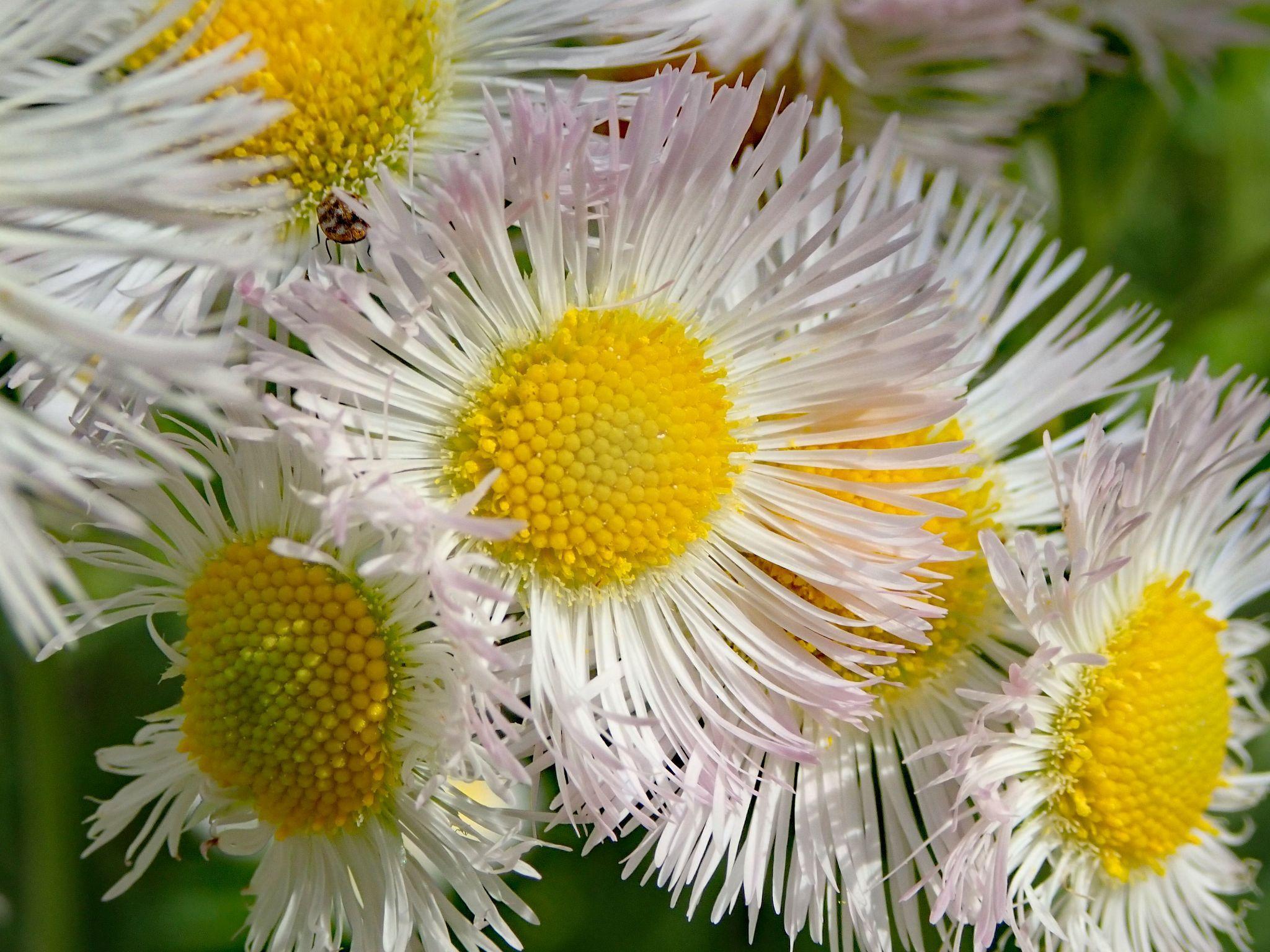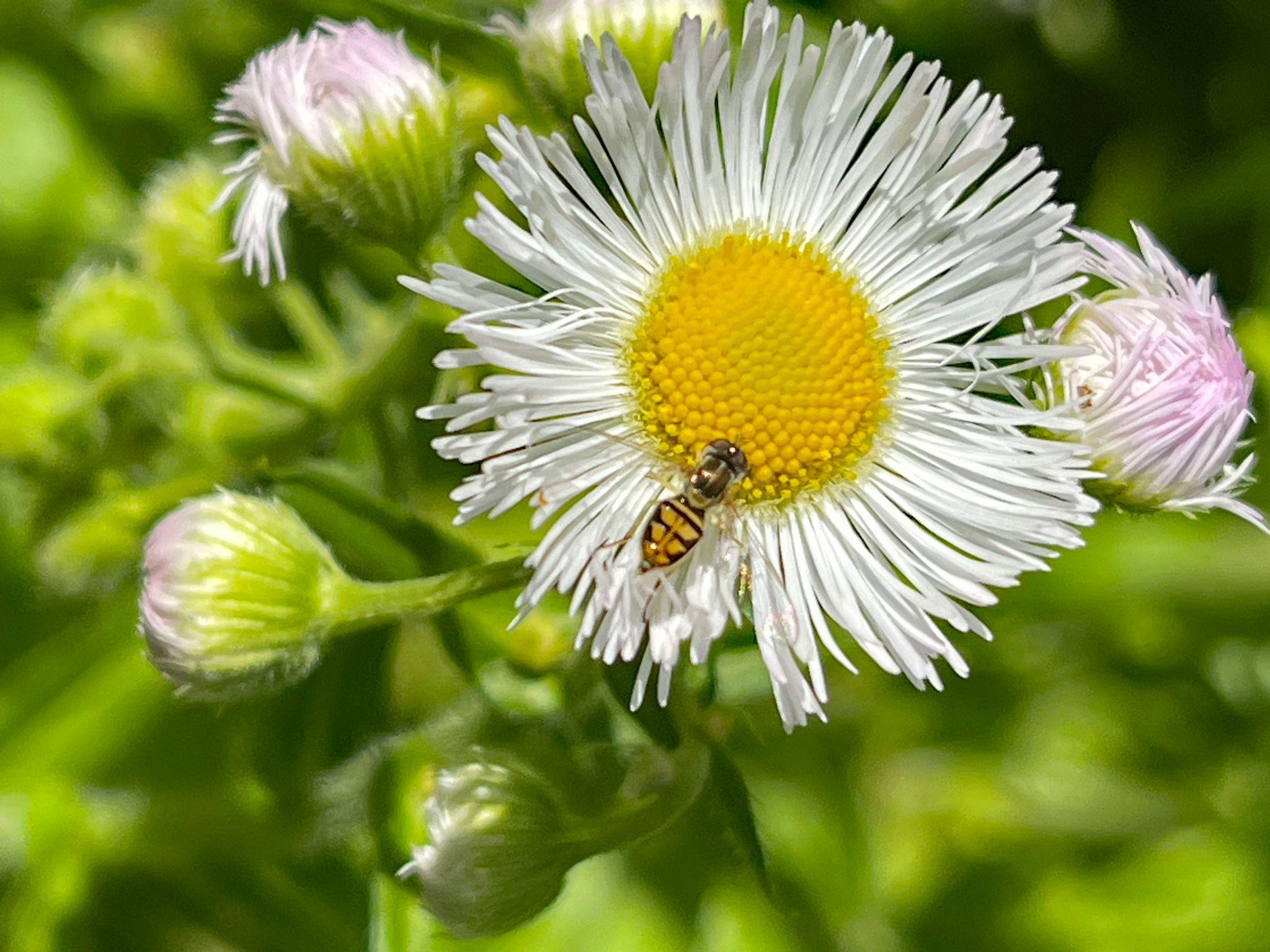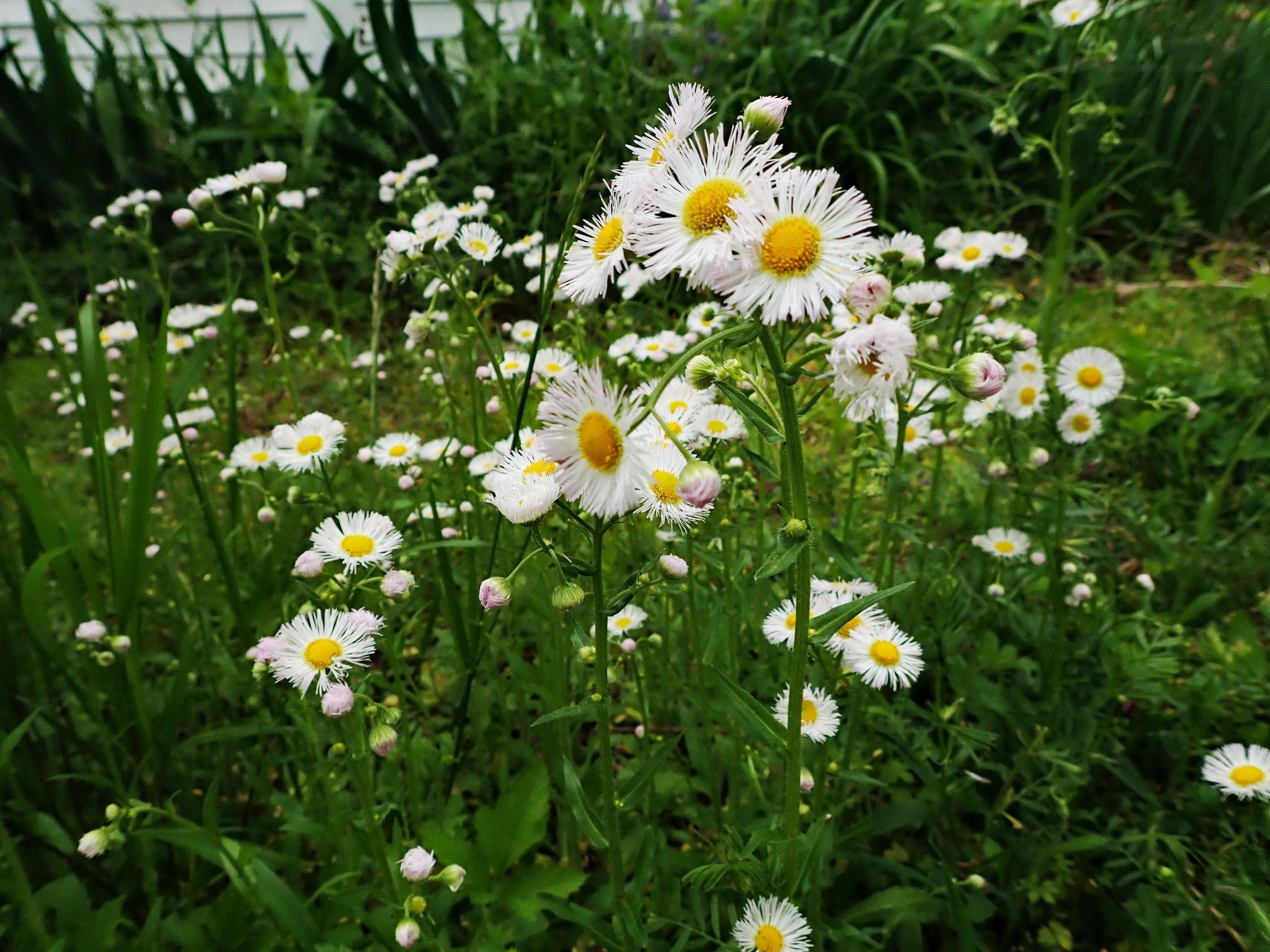I know daisy fleabane (Erigeron species), as a wildflower, but until recently did not make room for this plant in the garden. The fleabanes are a large group of plants in Asteraceae, the daisy family. As the name implies, fleabanes were once used to repel fleas, but the repellent features were not likely effective. Daisy fleabane flowers appear suddenly, attracting the smallest pollinators to small bright flowers held about 2 – 4 feet above the ground. These attractive plants are beneficial to the many small insects important to the healthy garden system. Now, I transplant misplaced fleabanes to the garden.
The composite fleabane flower is actually a cluster of tiny flowers grouped together. These clusters of flowers attract pollinators and produce seeds. Fleabane flowers are small, with a white, pale pink fringe of thin petal-like ray flowers and yellow centers (disc flowers), see Image 1. Locally, fleabanes begin flowering in May and continue through the summer. The earlier bloom period and numerous ray flowers distinguish fleabanes from asters.

Many fleabane species are quite similar. The Flora of Virginia lists six species in the genus Erigeron. E. strigosus and E. annuus are described as ‘common throughout’. E. philadelphicus and E. pulchellus are described as ‘infrequent in the Coastal Plain. E. vernus and E. quercifolius are listed as rare. E. vernus is found in the Coastal Plain and on the Eastern Shore. Of the six species, E.quercifolius is also listed as introduced. Below are brief descriptions of four fleabanes which could contribute to our gardens.
Annual Fleabane (Erigeron annuus)
- Annual species of field margins and disturbed ground.
- Described by the Penn State Extension as a turf grass weed which is first visible in early spring as a rosette of green leaves. The basal leaves are lanceolate to ovate, hairy and coarsely toothed. The upper leaves along the stem are smaller.
- Flowers May to August, occasionally later in mild years.
- According to the Illinois Wildflower website description Annual fleabane can be very difficult to tell from Daisy fleabane, but typical Annual fleabane plants are usually taller, have broader, toothed leaves and stem hairs tend to be a little denser and longer.
Prairie (Daisy) Fleabane (Erigeron strigosus)
- Annual or biennial in similar habitats as E. annuus.
- Flowers May to August, occasionally later in mild years.
- As described on the Illinois Wildflower website, can be very difficult to tell from E. annuus, typical plants are usually shorter, have narrower, untoothed leaves and stem hairs tend to be sparse and short, pressed against the stem, which is green and longitudinally grooved along the sides.
- Fewer and more slender leaves than annual fleabane.
Robin’s-plantain (Erigeron pulchellus var. pulchellus)
- Stoloniferous perennial found in open, well-drained, rocky to sandy soils in partial shade.
- Robin’s-plantain can be an attractive ground-cover year round.
- Early spring flowering stems are showy.
Writer Mary Reid Barrow of Lynnhaven River Now, describes the E. pulchellus var ‘Lynnhaven Carpet’, found near the Lynnhaven River in Virginia Beach, Virginia as “easy going. It takes sun and part shade and tolerates almost any kind of conditions”.
Philadelphia Fleabane (Erigeron philadelphicus)
- Biennial or perennial grows in moist to very wet conditions, such as wet meadows and grassy openings, low pastures, and wet roadsides. The size of the plant varies with habitat.
- Leaves are clasping.
- Flowers have a large number of rays.
Weedy is a term frequently used to describe fleabanes. Weedy plants are able to colonize open spaces and are tolerant of human activity. The website IllinoisWildflower.info has a nice summary about these plants: ‘While the fleabanes (Erigeron spp.) are often dismissed as ‘weeds’ because of their ubiquitousness during the summer, they are actually rather attractive plants that are beneficial to many small insects that have important roles in the functioning of the ecological system. As pioneer species, fleabanes are also useful in providing early cover for exposed ground, thereby reducing soil erosion.’ Using fleabanes as a native plant addition to a garden increases that garden’s diversity and supports wildlife.

Image 2 illustrates one of our indigenous small native pollinators, a Syrphid fly on a fleabane flower. Fleabanes also provide nectar for a variety of butterflies and moths (Eastern Tailed-blue, Variegated fritillary, Eastern black swallowtail, Red admiral, Grey hairstreak, Peck’s skipper, Orange mint moth) and are a host plant for White-lined Sphinx moth.
During my struggle to identify the fleabanes in my yard, I have depended on the many sources for information listed at the end of this article. I found the descriptions and photographs on two websites in particular, IllinoisWildflower.info and bplant.org, to be helpful when identifying fleabane plants. Both websites describe the habitat, life cycle and faunal associations of fleabanes. The Master Gardeners of Northern Virginia (mgnv.org) also list the insects which utilize fleabanes. If you are not experienced identifying wildflowers, a good start can be made with the website capemaywildlife.com.
If you are growing fleabanes in your garden or have found these plants on the Eastern Shore, why not share a picture with us? Email to info@esvmg.com. After reviewing fleabanes, let’s consider this weed a wildflower.

Acknowledgments
I wish to thank fellow Extension Master Gardeners Cindy Holdren and Janet Rochester for their support and encouragement.
Sources
Cape May Plants. Asters & Fleabanes. Retrieved 12/05/2022, from Asters (capemaywildlife.com)
Lawn and turfgrass weeds: Annual or Daisy Fleabane. Posted 12/26/2022. Penn State Extension, Retrieved 01/09/2023, from Lawn and Turfgrass Weeds: Annual or Daisy Fleabane (psu.edu)
LRNow Nature Notes. (April 30, 2021). Mary Reid Barrow. Lynnhaven River Now. Retrieved 01/28/2023, from Lynnhaven Carpet, one of Virginia Beach’s claims to botanical fame – Lynnhaven River NOW
Illinois Wildflowers. www.illinoiswildflowers.info Prairie Wildflowers of Illinois, Weedy Wildflowers of Illinois, Retrieved 01/28/2023, from https://www.illinoiswildflowers.info/weeds/plants/an_fleabane.htm , https://www.illinoiswildflowers.info/prairie/plantx/ph_fleabanex.htm , https://www.illinoiswildflowers.info/prairie/plantx/ds_fleabanex.htm .
University of California Agriculture & Natural Resources. Statewide Integrated Pest Management Program.Syrphids (Flower Flies, or Hover Flies) Retrieved 01/28/2022, from https://ipm.ucanr.edu/natural-enemies/syrphids/.
Digital Atlas of the Virginia Flora. Browsing family Asteraceae. http://www.vaplantatlas.org/ . Retrieved 01/28/2023, from http://Digital Atlas of the Virginia Flora | Erigeron annuus (L.) Pers. ,
http://Digital Atlas of the Virginia Flora | Erigeron pulchellus Michx. var. pulchellus , http://Digital Atlas of the Virginia Flora | Erigeron vernus (L.) Torr. & Gray ,
https://Digital Atlas of the Virginia Flora | Erigeron strigosus Muhl. ex Willd. var. strigosus ,
http://Digital Atlas of the Virginia Flora | Erigeron quercifolius Lam.
Master Gardeners of Northern Virginia. Nectar and Host Plants for Selected Mid-Atlantic Butterflies and Moths. Retrieved 01/30/2023, from Nectar and Host Plants for Selected Mid-Atlantic Butterflies and Moths (mgnv.org)
Annual Fleabane (Erigeron annuus) – bplant.org retrieved 02/23/2024
Robin’s Plantain (Erigeron pulchellus) – bplant.org retrieved 02/23/2024
